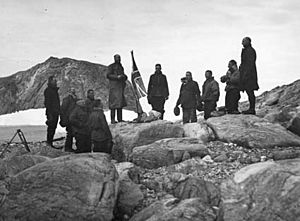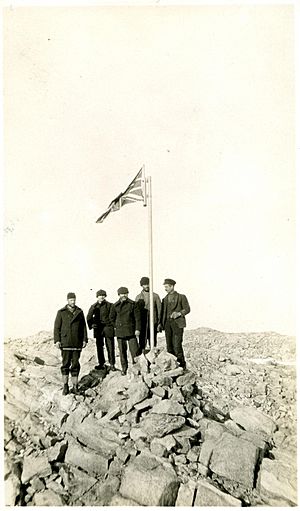British Australian and New Zealand Antarctic Research Expedition facts for kids
The British Australian (and) New Zealand Antarctic Research Expedition (BANZARE) was an exciting journey to Antarctica between 1929 and 1931. It involved two trips during the Antarctic summers. This expedition was a big project from the British Commonwealth, mainly supported by the United Kingdom, Australia, and New Zealand.
The main goal of BANZARE was to explore and claim new lands in Antarctica. It was also a scientific mission, studying the icy continent. The expedition helped map parts of Antarctica and led to Australia claiming a large area of the continent later on.
Contents
Leading the Expedition
The leader of the BANZARE expedition was a famous explorer named Sir Douglas Mawson. He had explored Antarctica before. The team sailed on a ship called the [RRS Discovery], which was a special ship. It had been used by another famous explorer, Robert Falcon Scott, on his own Antarctic journeys.
For the second summer trip, Captain Kenneth N. MacKenzie took over from Captain John King Davis as the ship's commander. The expedition also used a small airplane to fly over the land. This helped them map the coastline of Antarctica more easily.
Discovering New Lands
During their voyages, the BANZARE team mapped many parts of Antarctica's coast. They discovered two important areas:
- Mac. Robertson Land
- Princess Elizabeth Land
These lands were later claimed as part of the Australian Antarctic Territory. This means they became a special part of Australia's territory in Antarctica.
Claiming Territory
A big part of the BANZARE expedition was about claiming land. Sir Douglas Mawson made special announcements, called proclamations, at five different places where they landed. He declared these lands belonged to the British. The plan was for these territories to be given to Australia later, which happened in 1933.
One important proclamation was made on January 5, 1931, at a place called Cape Denison. This was the same spot where Mawson's earlier expedition had stayed in 1912–13. A handwritten copy of the proclamation was left there. It was put inside a container made from food tins and buried under a pile of rocks. Years later, in 1977, an Australian team found this letter. It is now kept in the Mawson collection at the National Museum of Australia.
Scientific Discoveries
Even though claiming land was a big focus, BANZARE was also a very important scientific mission. The expedition collected lots of information and samples. Scientists studied many different things, including:
- Geology (the study of rocks and the Earth)
- Oceanography (the study of the oceans)
- Meteorology (the study of weather)
- Terrestrial magnetism (the Earth's magnetic field)
- Zoology (the study of animals)
- Botany (the study of plants)
All the findings from the expedition were written down in 13 large books, called reports. These reports were published between 1937 and 1975. Robert Falla was one of the scientists, working as an assistant zoologist.
See also
- List of Antarctic expeditions



